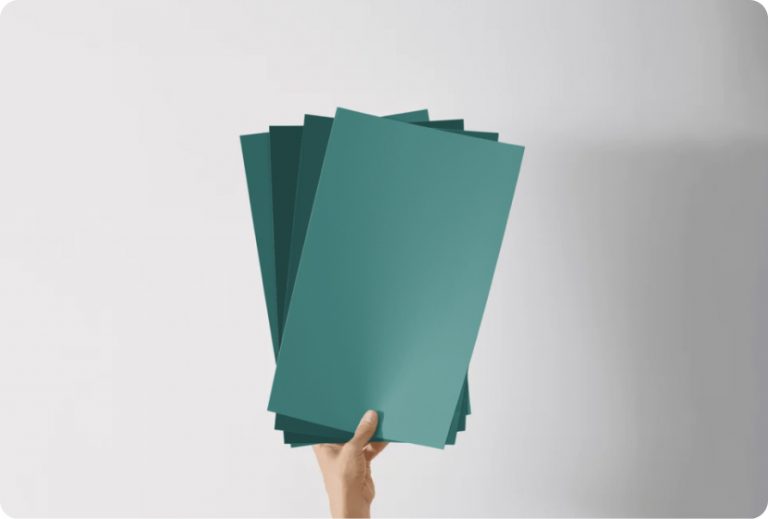Have you ever stood before a wall freshly painted with Benjamin Moore’s 2133-50 Pigeon Gray and felt an unexpected calm? If not, you might want to give this shade a try. Soft, subtle, and soothing, Pigeon Gray carries a hint of neutrality that makes it adaptable for any room in your home.
Whether you’re looking to refresh your living room, bedroom, or even the kitchen, this color strikes a perfect balance between warmth and coolness. Its unique ability to complement a wide range of decors is why I chose it for several areas in my home. You might be wondering what makes Pigeon Gray stand out among other grays.
Well, it has a warm undertone that prevents it from feeling too industrial, yet it retains enough depth to make a refined statement. This color can act as a backdrop for vibrant hues or work harmoniously with other soft tones, offering flexibility in design choices.
From personal experience, pairing it with crisp whites can really make your area feel airy and more open, while combining it with darker shades can create a more grounded, cozy feel.
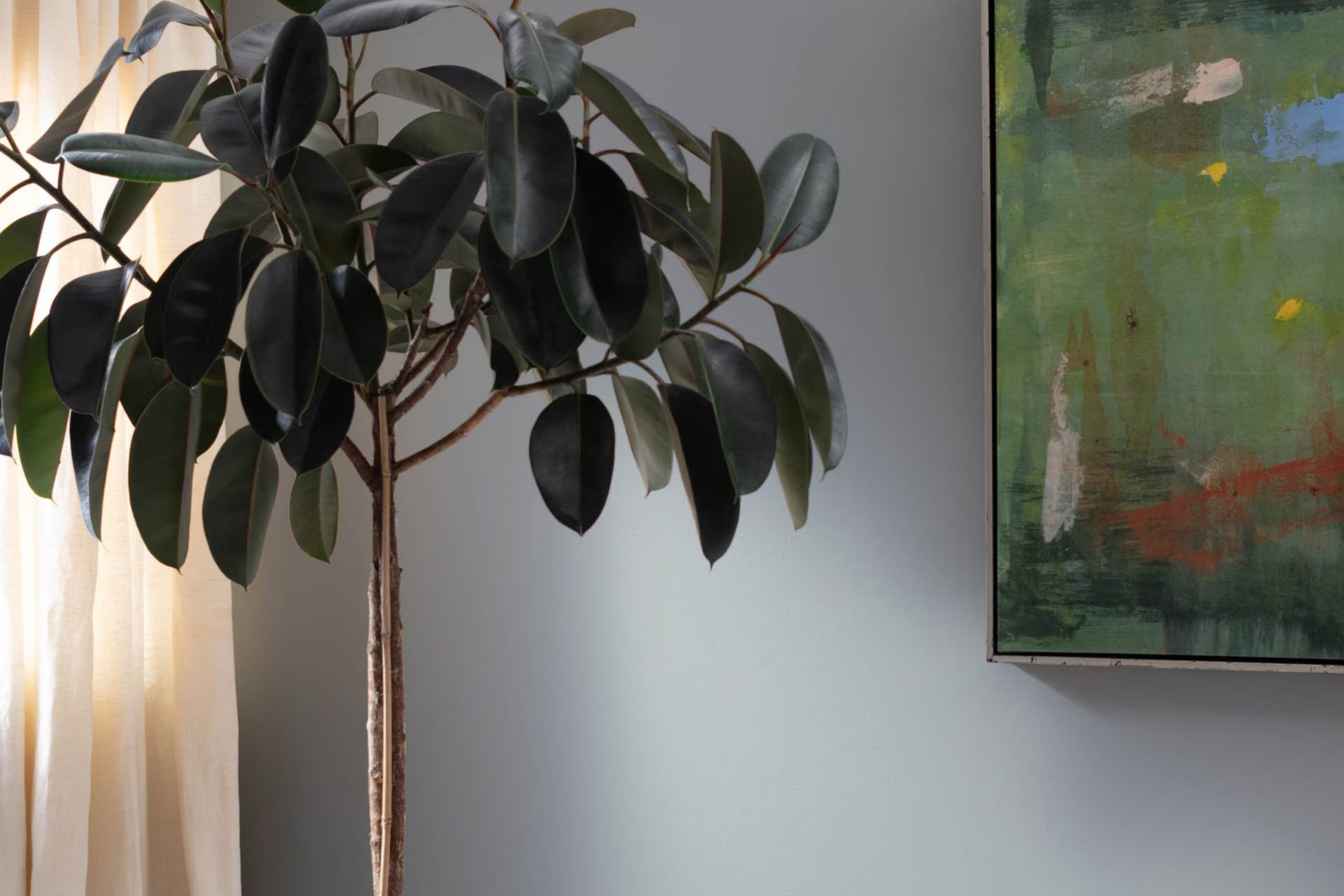
What Color Is Pigeon Gray 2133-50 by Benjamin Moore?
Pigeon Gray by Benjamin Moore is an adaptable and subtle shade that blends gray with soft undertones of blue. This color brings a gentle, calming effect to any room, making it an excellent choice for creating a peaceful and welcoming atmosphere. Pigeon Gray has a balanced, muted quality that works well in various lighting situations, ensuring the area remains cozy and visually appealing throughout the day.
This shade is perfect for contemporary, minimalist, and Scandinavian interior styles due to its clean and understated nature. Its neutrality allows it to serve as a beautiful backdrop against bold colors or as a harmonious base for a more monochromatic scheme.
Pigeon Gray pairs beautifully with natural materials like wood, enhancing its warm tones, or with metal accents such as brushed steel or chrome for a more modern touch. It also complements textures like linen, wool, and cotton, which contribute to a soft, layered look. Using this color on walls, furniture, or even cabinetry is a great way to provide a fresh yet enduring appeal to any interior, making areas feel open and airy yet grounded. Whether in a bedroom, living room, or kitchen, Pigeon Gray maintains a stylish and welcoming vibe.

Is Pigeon Gray 2133-50 by Benjamin Moore Warm or Cool color?
Pigeon Gray 2133-50 by Benjamin Moore is an adaptable shade that offers a soft, neutral backdrop in many home settings. This particular gray presents a gentle mix of blue and green undertones, making it unique yet understated. Its flexibility means it can fit seamlessly into various rooms, whether you’re looking to create a cozy living area or a calm, focused office environment.
Because of its mild tone, Pigeon Gray pairs well with a wide range of other colors. It can complement bright and bold hues, bringing balance to lively design schemes, or match with other neutrals for a more subdued look. In a living room, it can help make the area feel more inviting, while in a bedroom, it helps set a restful mood without being too dark or intense.
The color also works beautifully in bathrooms or kitchens, where it can offer a clean, fresh look that’s easy to accessorize with different textures and finishes. Overall, Pigeon Gray is a practical choice for homeowners looking to add a touch of understated elegance to their interiors.
Undertones of Pigeon Gray 2133-50 by Benjamin Moore
Pigeon Gray might seem straightforward, but it carries a fascinating array of undertones that significantly impact its appearance. Undertones are subtle colors that lurk beneath the surface of the main color, and they can alter how we perceive a color depending on the lighting and surrounding colors.
The undertones of Pigeon Gray include light blue, light purple, lilac, pale yellow, mint, grey, and pale pink. This mix makes Pigeon Gray highly adaptable. In rooms with ample sunlight, the pale yellow and mint undertones might become more pronounced, giving the walls a fresh and lively look. Conversely, in a dimly lit room, the light purple and lilac could make the color appear more subdued and cooler.
The grey and pale pink undertones add a softness to the color, making it a great option for creating a soothing environment in places like the bedroom or living room. It is generally appealing because these undertones help the color adjust to various decor styles and settings.
When you paint your walls with this color, these different undertones can subtly influence the mood and feel of the room. This makes Pigeon Gray not just a simple paint choice, but a dynamic backdrop that reacts to its environment, altering its vibe with changes in light and area arrangements.
decorcreek.com
What is the Masstone of the Pigeon Gray 2133-50 by Benjamin Moore?
Pigeon Gray 2133-50 by Benjamin Moore has a masstone of light gray, indicated by the color code #D5D5D5. This light gray shade is incredibly adaptable and works well in many home environments. Its lightness helps to make small areas appear larger and more open, making it a great choice for rooms like apartments or smaller living areas.
This shade of gray also reflects natural light effectively, which can help to brighten a room and create a warm, welcoming atmosphere. Because of its neutral tone, Pigeon Gray matches well with a variety of decor styles and colors, from bold and bright to more muted earth tones.
It serves as a subtle backdrop that allows other elements in the room, like furniture and artwork, to stand out. Its flexibility makes it suitable for common areas like living rooms and kitchens as well as more private areas such as bedrooms and home offices. Whether aiming for a modern look or a more classic style, Pigeon Gray provides a solid foundation for any interior design.
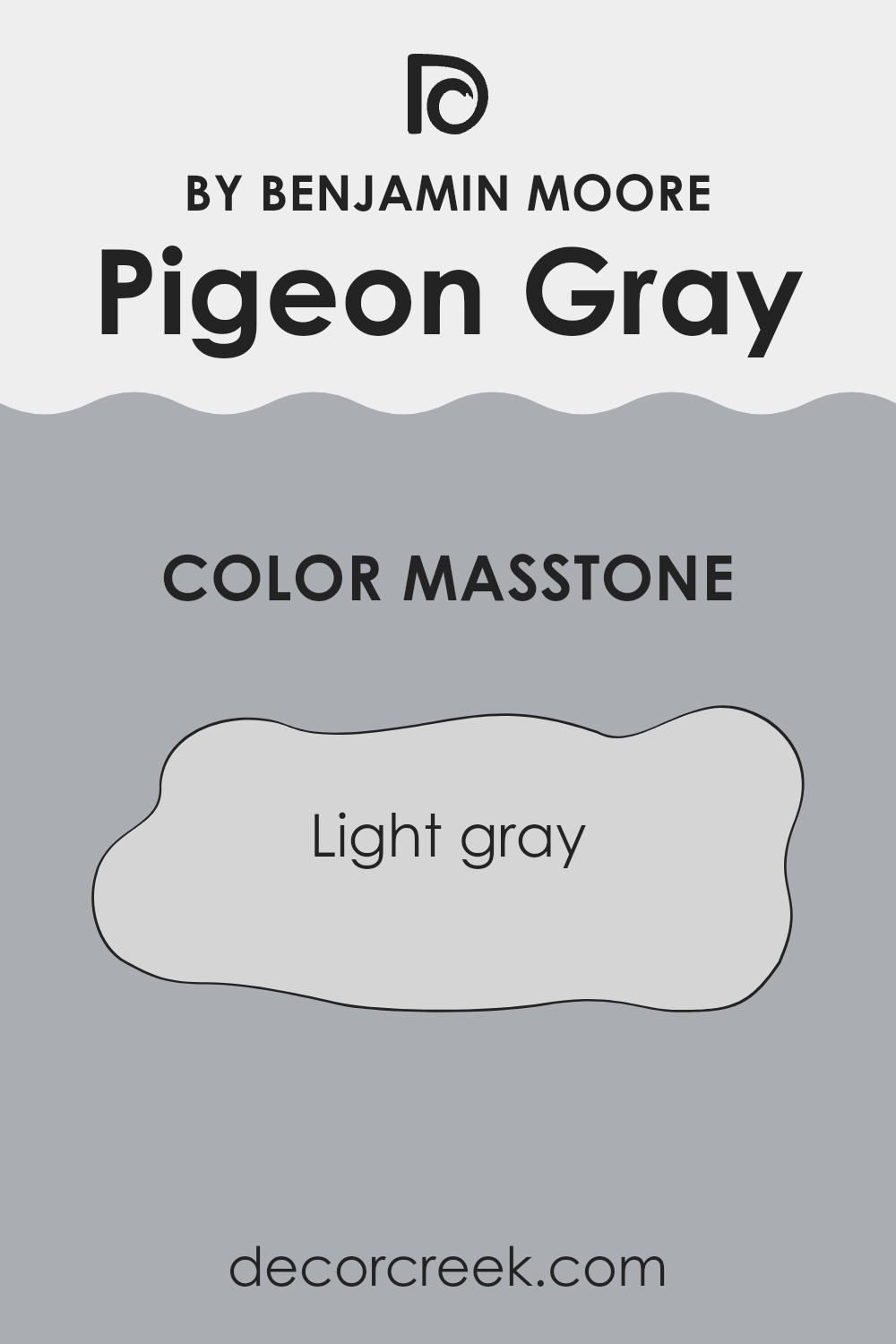
How Does Lighting Affect Pigeon Gray 2133-50 by Benjamin Moore?
How Lighting Affects Colors: The Example of Pigeon Gray by Benjamin Moore
Lighting plays a crucial role in how we perceive colors in an environment. Both natural and artificial light sources can change how a color looks, impacting the mood and style of an area. Let’s discuss the color Pigeon Gray by Benjamin Moore and how it varies under different lighting conditions.
Artificial Light: In artificial lighting, Pigeon Gray tends to appear warmer and more muted. This is because most artificial lights, like incandescent bulbs, emit a yellowish light, which can soften the color. If the artificial light is cooler, like some LEDs, the gray will look sharper and more blue-toned.
Natural Light: Natural light brings out the truest form of Pigeon Gray. During the daylight hours, when the sun is the brightest, this color will show its clean, crisp characteristics. The exact tone can shift from a cool gray in the bright midday light to a softer, warmer gray near sunrise or sunset.
Room Orientation:
- North-Faced Areas: These usually get less direct sunlight, which may make Pigeon Gray appear slightly darker and cooler. The lack of intense sunlight can accentuate the blue undertones in the gray, giving the area a calm and quiet feel.
- South-Faced Areas: With more direct sunlight, Pigeon Gray in south-facing areas looks lighter and warmer. The ample sunlight can reduce the perceived coolness of the gray, making the area feel more open and welcoming.
- East-Faced Areas: Morning light is warm, so Pigeon Gray in east-facing areas will have a soft, warm glow in the morning that transitions to a cooler tone as the day progresses. This makes east-facing areas have a dynamic nature, shifting mood from morning to evening.
- West-Faced Areas: In areas facing west, the color will experience the reverse of east-facing ones. Evenings will bring in a warm light that intensifies the warmth of the gray, whereas the color will appear more neutral and subdued in the morning light.
Understanding how Pigeon Gray behaves under various lighting conditions can help in deciding how and where to use this color effectively within an area for desired moods and effects.
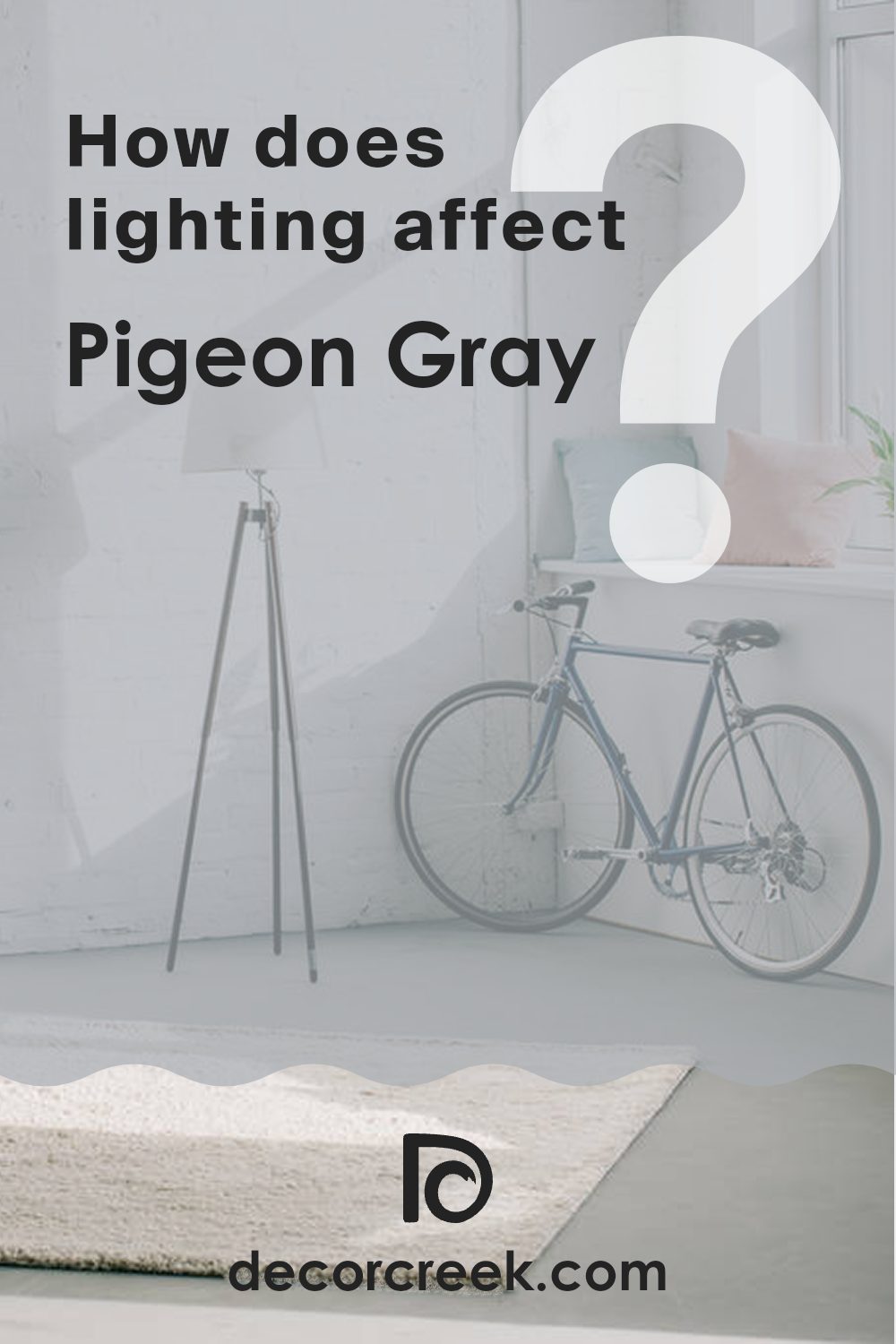
What is the LRV of Pigeon Gray 2133-50 by Benjamin Moore?
LRV stands for Light Reflectance Value, a measure used to indicate how much light a color reflects or absorbs when painted on a surface. This value is expressed on a scale from zero to one hundred, where zero represents pure black, meaning it absorbs all light, and one hundred represents pure white, reflecting all light back.
The LRV helps in selecting paint colors by indicating how light or dark a color will look once it’s on your walls. A higher LRV means the color will appear lighter, making areas feel more open and airy, while a lower LRV indicates a darker shade, which can make areas look smaller and cozier.
With an LRV of 42.18, Pigeon Gray by Benjamin Moore is a medium-range color, neither too dark nor too light. This middle ground means it has a balanced flexibility, suitable for various lighting situations. In a well-lit area, this paint will look somewhat lighter, contributing to a fresher feel, whereas in a dimly lit area, it might appear a bit darker, bringing a warmer tone to the room. This particular value makes Pigeon Gray an adaptable choice that can fit well with different styles and preferences, enhancing the room’s aesthetic without overpowering it with either too much darkness or excessive brightness.
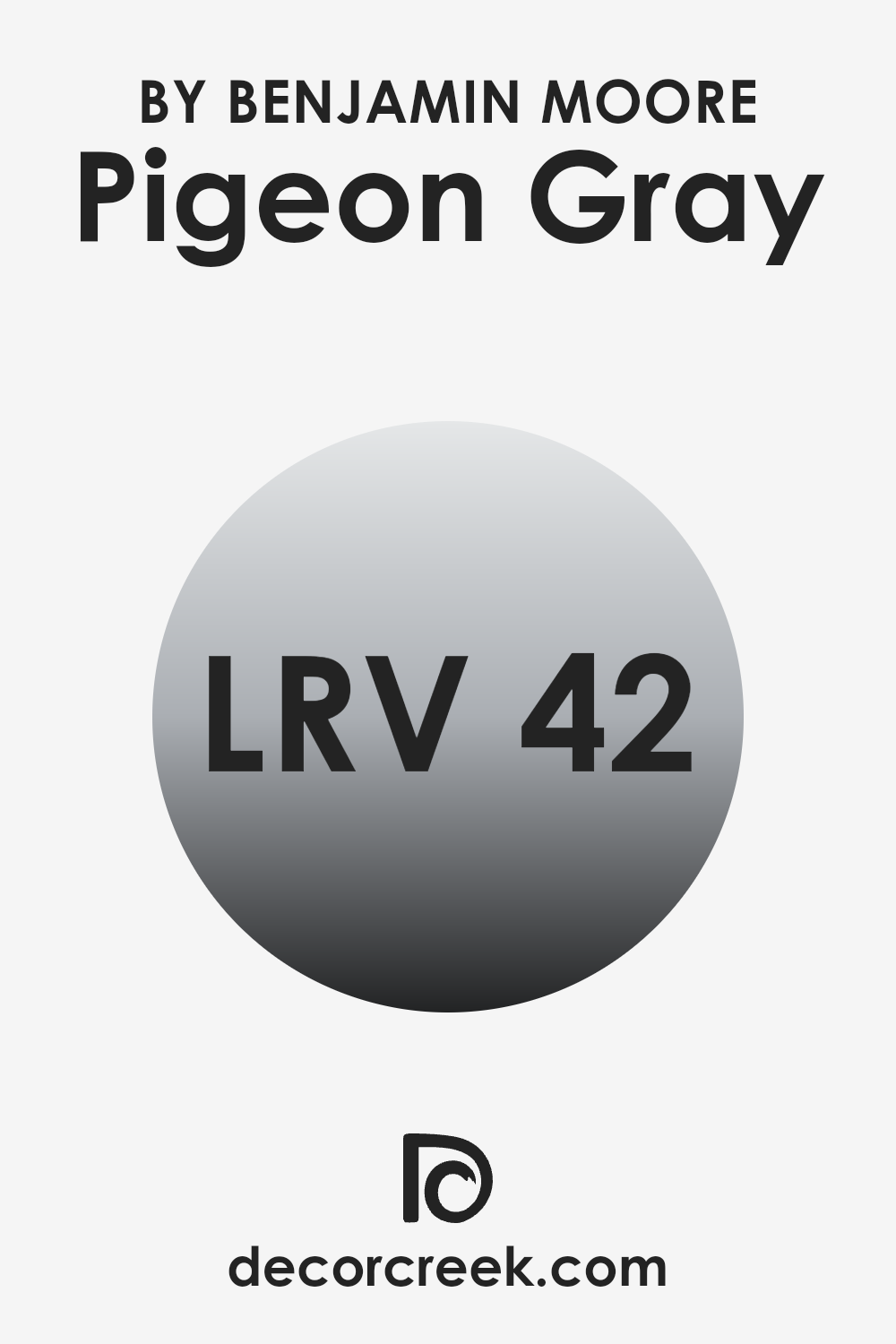
Coordinating Colors of Pigeon Gray 2133-50 by Benjamin Moore
Coordinating colors are shades that complement each other when used together in an area, creating a pleasing and harmonious look. When choosing coordinating colors, one typically looks for hues that share similar undertones or that balance each other out, making a room feel more cohesive. For example, when working with an adaptable and calm shade like Pigeon Gray by Benjamin Moore, selecting the right coordinating colors can enhance the overall aesthetic without being too intense.
Dream Whip 2174-60 is a gentle off-white with a creamy texture that pairs beautifully with Pigeon Gray to create a light and airy feel in any room. It’s an excellent choice for trim or ceilings that can help brighten darker areas. First Snowfall 1618 has a subtle blue undertone, giving it a fresh and clean look that works wonderfully with the cooler aspects of Pigeon Gray.
Such a combination could be ideal for a soothing bedroom or a peaceful study area. Decorator’s White OC-149 is a crisp white that provides a stark, contrasting background, making it a suitable option for modern areas looking to highlight Pigeon Gray’s depth. Lastly, Chantilly Lace OC-65 is known for its pure and bright qualities, making any area feel open and inviting. This color can help maintain a neutral palette while adding a spark of brightness against the muted tones of Pigeon Gray, perfect for living areas or kitchens.
You can see recommended paint colors below:
- 2174-60 Dream Whip
- 1618 First Snowfall
- OC-149 Decorator’s White
- OC-65 Chantilly Lace
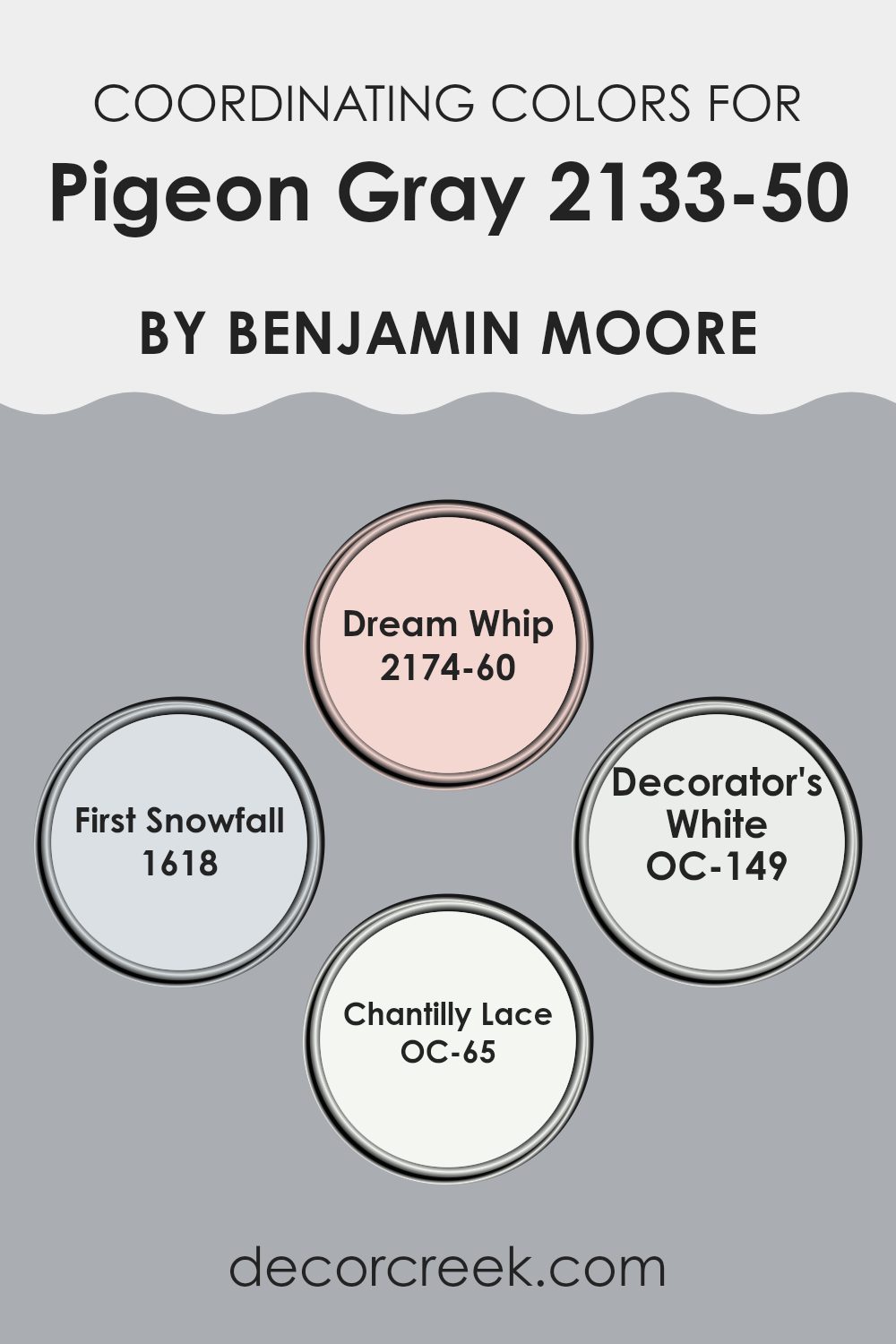
What are the Trim colors of Pigeon Gray 2133-50 by Benjamin Moore?
Trim colors are used to highlight or complement the main color on walls, window frames, doors, and other architectural features of a room or an exterior. Selecting the right trim color enhances the overall aesthetics, creating a clean and finished look. When paired with Pigeon Gray by Benjamin Moore, choosing the right trim color becomes crucial to define and subtly contrast the area, showcasing architectural details and ensuring that they stand out naturally without being too intense.
Cloud White OC-130 offers a clean and clear white that brings a sense of freshness and crispness, making it an excellent choice for trim as it gently supports the softer tone of Pigeon Gray, allowing it to remain the focal point without competing for attention.
White Diamond OC-61, on the other hand, has a slightly sparkling undertone that adds a touch of lightness around the edges where applied. It reflects light beautifully, providing a subtle yet effective contrast to the deeper tones of Pigeon Gray, thus enhancing the overall visual interest of the area. Together, these colors work seamlessly to accentuate Pigeon Gray, ensuring a harmonious and inviting environment.
You can see recommended paint colors below:
- OC-130 Cloud White
- OC-61 White Diamond

Colors Similar to Pigeon Gray 2133-50 by Benjamin Moore
Choosing similar colors, such as shades close to Pigeon Gray by Benjamin Moore, can create a cohesive and harmonious look in any area. These hues usually share a common base color but vary in brightness or saturation, allowing them to complement each other beautifully.
For example, using shades like Silver Spring and Nickel alongside Pigeon Gray can enhance the overall aesthetic without causing abrupt visual breaks, making the area feel more unified. This approach is particularly effective in achieving a subtle yet impactful design that is pleasing to the eye.
Silver Spring is a gentle gray that leans towards the lighter end of the spectrum, providing a fresh and airy feel to interiors. Nickel, slightly deeper, offers a medium tone that harmonizes well with both lighter and darker shades, making it adaptable for various design applications.
Silent Night steps into the realm with a bold, near-navy hue that adds depth and contrast when used with lighter grays. Meanwhile, Shadow Gray offers a muted charcoal color that is ideal for adding a touch of elegance without being too intense in a room’s palette. Together, these colors present a range of options that can suit diverse design needs, whether looking for contrast or continuity.
You can see recommended paint colors below:
- 2120-50 Silver Spring
- 2119-50 Nickel
- 1613 Silent Night
- 2125-40 Shadow Gray

Colors that Go With Pigeon Gray 2133-50 by Benjamin Moore
Choosing complementary colors for Pigeon Gray 2133-50 by Benjamin Moore can greatly enhance the aesthetic appeal and atmosphere of any area. The right color combinations can create balance and harmony within the environment. When paired thoughtfully, these colors can accentuate the gentle tones of Pigeon Gray and provide either a subtle backdrop or a striking contrast, depending on the desired effect. It is crucial to select colors that complement Pigeon Gray to achieve a cohesive and appealing look.
Among the colors that pair well with Pigeon Gray, Sidewalk Gray offers a lighter, softer gray that can help brighten an area while maintaining a calm coolness. This makes it ideal for creating a light and airy feel in places like kitchens and bathrooms. Charcoal Linen, on the other hand, introduces a deeper, warmer tone that works wonderfully in creating a cozy and welcoming atmosphere in living areas or bedrooms.
Day’s End, an even darker shade, allows you to add depth and intensity to an accent wall or furniture, giving the area a dramatic flair. Black Jack and Onyx are the boldest options, providing a strong contrast that can be perfect for modern and minimalist designs, making striking visual statements with trim or decor items.
The softest option, Tundra, is a mild off-white that complements Pigeon Gray by subtly lifting the overall lightness of an area, great for creating a soft, restful environment.
By choosing any of these colors, one can enhance the inherent beauty of Pigeon Gray, making it easy to achieve a harmonious and attractive decor scheme.
You can see recommended paint colors below:
- 2133-60 Sidewalk Gray
- 2133-40 Charcoal Linen
- 2133-30 Day’s End
- 2133-20 Black Jack
- 2133-10 Onyx
- 2133-70 Tundra
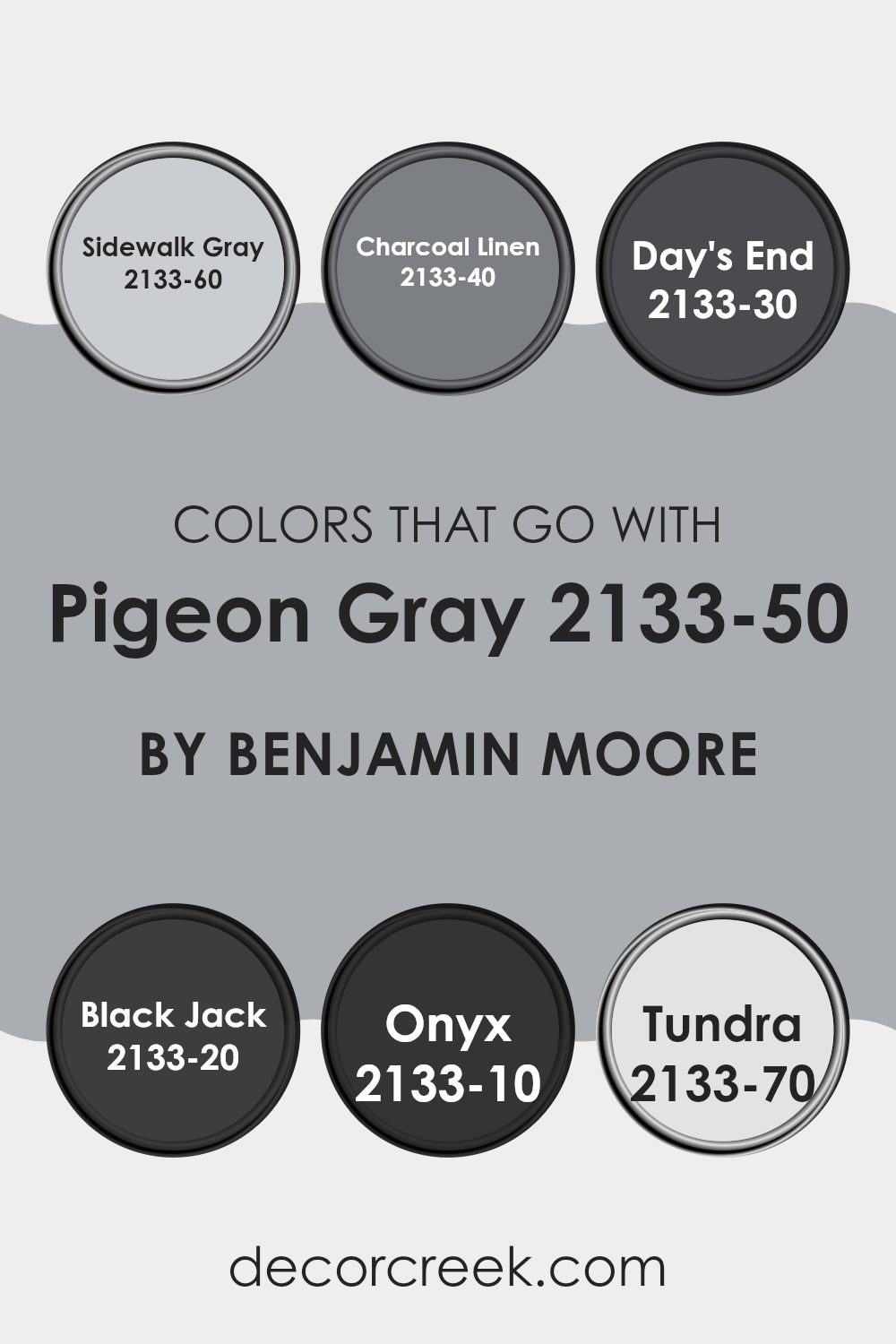
How to Use Pigeon Gray 2133-50 by Benjamin Moore In Your Home?
Pigeon Gray 2133-50 by Benjamin Moore is an adaptable shade that fits well in many areas of a home. Its gentle tone works beautifully in living rooms and bedrooms, creating a calming atmosphere that makes these areas feel inviting. This color pairs well with both modern and traditional decor, allowing for flexibility in furnishing choices. In a bathroom, Pigeon Gray can add a subtle elegance, complementing white fixtures and providing a nice contrast to bright accents.
For those looking to refresh their kitchen, this shade can be a great choice for cabinets or walls, lending a fresh yet warm touch to the culinary area. Additionally, its neutral character makes it easy to match with various colors and textures, from wood to metal finishes.
This paint is also durable and easy to maintain, making it suitable for high-traffic areas like hallways and entryways, where scuffs and marks are more common. Using Pigeon Gray can refresh your home’s look without making your existing decor feel too intense.
Pigeon Gray 2133-50 by Benjamin Moore vs Silver Spring 2120-50 by Benjamin Moore
Pigeon Gray and Silver Spring, both by Benjamin Moore, are subtle yet distinct colors suitable for modern areas. Pigeon Gray is a softer, warmer gray that can make an area feel cozy and inviting. It’s ideal for living areas or bedrooms where a gentle color is preferable.
On the other hand, Silver Spring is a cooler shade of gray that leans a bit towards a lighter, almost silvery hue. This color works great in areas that benefit from a bright and airy feel, such as bathrooms and kitchens. It has a freshness that can help areas seem more open.
While both colors share a gray base, Pigeon Gray offers warmth that enhances a snug atmosphere, whereas Silver Spring provides a cleaner, crisper look that can help brighten and open up a room. This makes each color unique in its way, suitable for different preferences and area functions.
You can see recommended paint color below:
- 2120-50 Silver Spring

Pigeon Gray 2133-50 by Benjamin Moore vs Silent Night 1613 by Benjamin Moore
The main color, Pigeon Gray, is a gentle, muted gray with cool undertones. It’s an adaptable shade that works well in areas where you want a calm, subtle backdrop. This color is particularly effective in areas with ample natural light, as it reflects the light softly, creating a peaceful setting.
On the other hand, Silent Night is a deeper, more intense color. It’s a dark gray with blue undertones that give it a more pronounced presence in a room. This hue is ideal for making a statement or accenting an area. It pairs well with bright trims for a bold contrast or can be used in a monochromatic color scheme to create a more cohesive look.
Both colors offer unique advantages, with Pigeon Gray providing a light, airy feel, and Silent Night offering depth and drama. A choice between them would depend on the desired mood and effect in your area.
You can see recommended paint color below:
- 1613 Silent Night

Pigeon Gray 2133-50 by Benjamin Moore vs Shadow Gray 2125-40 by Benjamin Moore
Pigeon Gray and Shadow Gray by Benjamin Moore are two distinct shades, each offering a unique vibe to areas. Pigeon Gray leans towards a light, soft gray with a subtle blue undertone, giving it a fresh and airy feel. It’s great for making small areas appear more open and can effectively brighten rooms that don’t receive a lot of natural light.
On the other hand, Shadow Gray is a deeper, more pronounced gray. It has hints of both blue and green, which add a bit of depth and richness to the color. This makes it ideal for creating a cozy, more enclosed feeling in an area. It can work well in larger rooms or on accent walls where you want to draw more attention.
Both colors are adaptable and work well in modern decor, but the choice between them can depend on the mood you want to set and the specific characteristics of the area you are painting.
You can see recommended paint color below:
- 2125-40 Shadow Gray
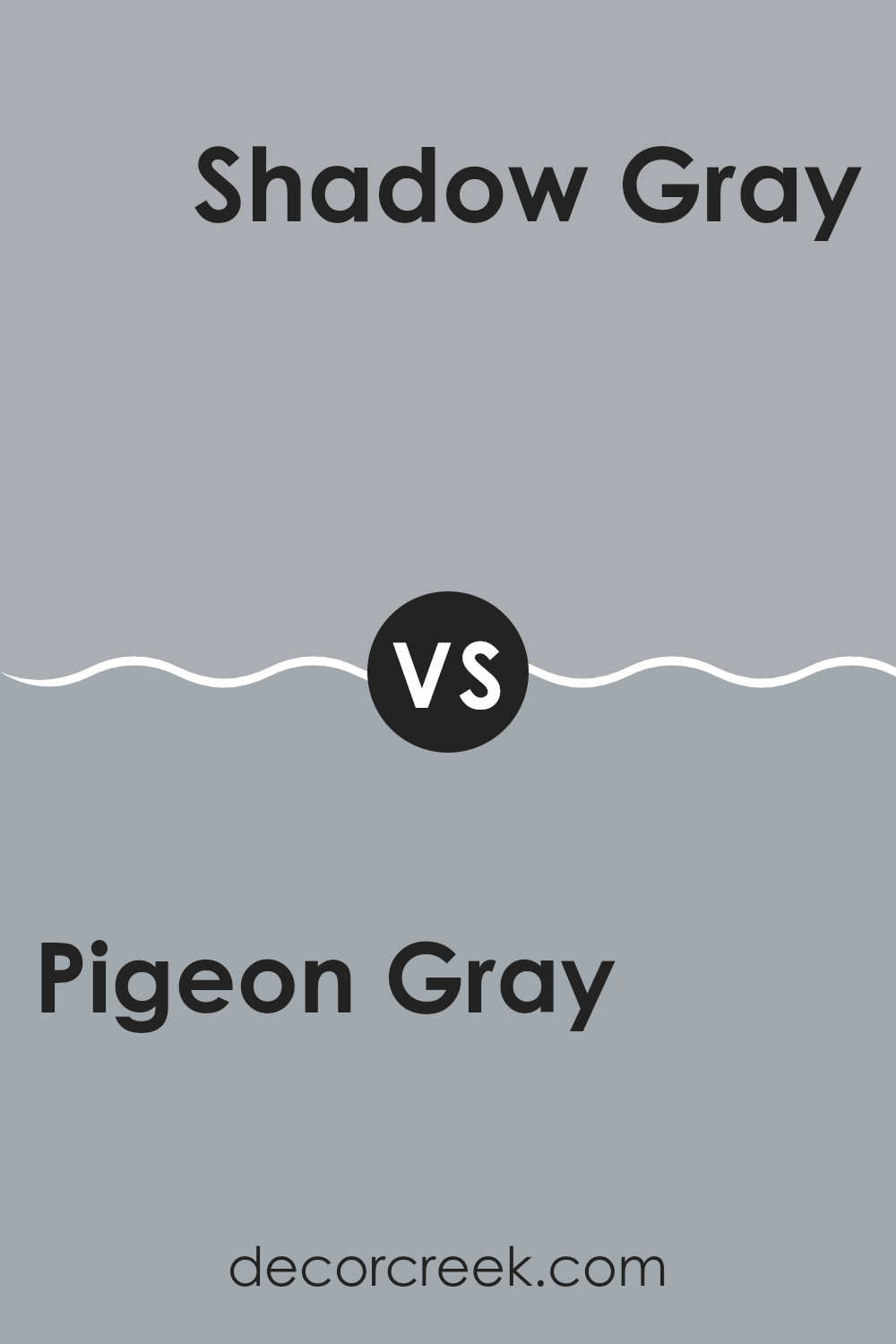
Pigeon Gray 2133-50 by Benjamin Moore vs Nickel 2119-50 by Benjamin Moore
The main color, Pigeon Gray, by Benjamin Moore, is a soft, subtle gray that offers a calm and gentle ambiance to any area. It leans slightly towards a warm tone, making it an excellent choice for creating a cozy atmosphere in rooms like living areas and bedrooms.
Meanwhile, Nickel, another Benjamin Moore color, is also a gray shade but with a cooler undertone. It tends to bring a fresh, modern feel to environments, particularly useful in places that benefit from a cleaner, more contemporary look, such as home offices or modern kitchens.
When comparing these two, Pigeon Gray provides a warmer and more inviting feel, suitable for a plush and comfy setting. In contrast, Nickel offers a sharper, more defined gray that fits well with sleek, modern decor. Both colors promote a neutral palette, but their warm and cool undertones set them apart, allowing them to suit different decorative styles and preferences.
You can see recommended paint color below:
- 2119-50 Nickel

In wrapping up, 2133-50 Pigeon Gray by Benjamin Moore is truly a fantastic choice if you’re thinking about giving your room a fresh look. What I really love about Pigeon Gray is how calm and gentle it feels. It’s not too dark or too light, just a perfect shade of gray that seems to make any area look nice and cozy.
This color works well in lots of different places in a home. Whether you want to paint your bedroom, living room, or even the kitchen, Pigeon Gray fits right in. I noticed that when I used this paint in my study, it made the area feel warm and inviting, which is exactly what I wanted.
Pigeon Gray also doesn’t get boring. Even though it’s just gray, it has a kind of warmth that keeps the room feeling lively, not dull. It’s easy to match with different colors of furniture or decorations, so you can keep adding new things to your area without worrying if they’ll look good with the walls.
So, if you’re thinking about picking a new color for any room, I definitely recommend 2133-50 Pigeon Gray from Benjamin Moore. It’s simple, it’s pretty, and it makes any area feel just right. What more could you want from a paint color?
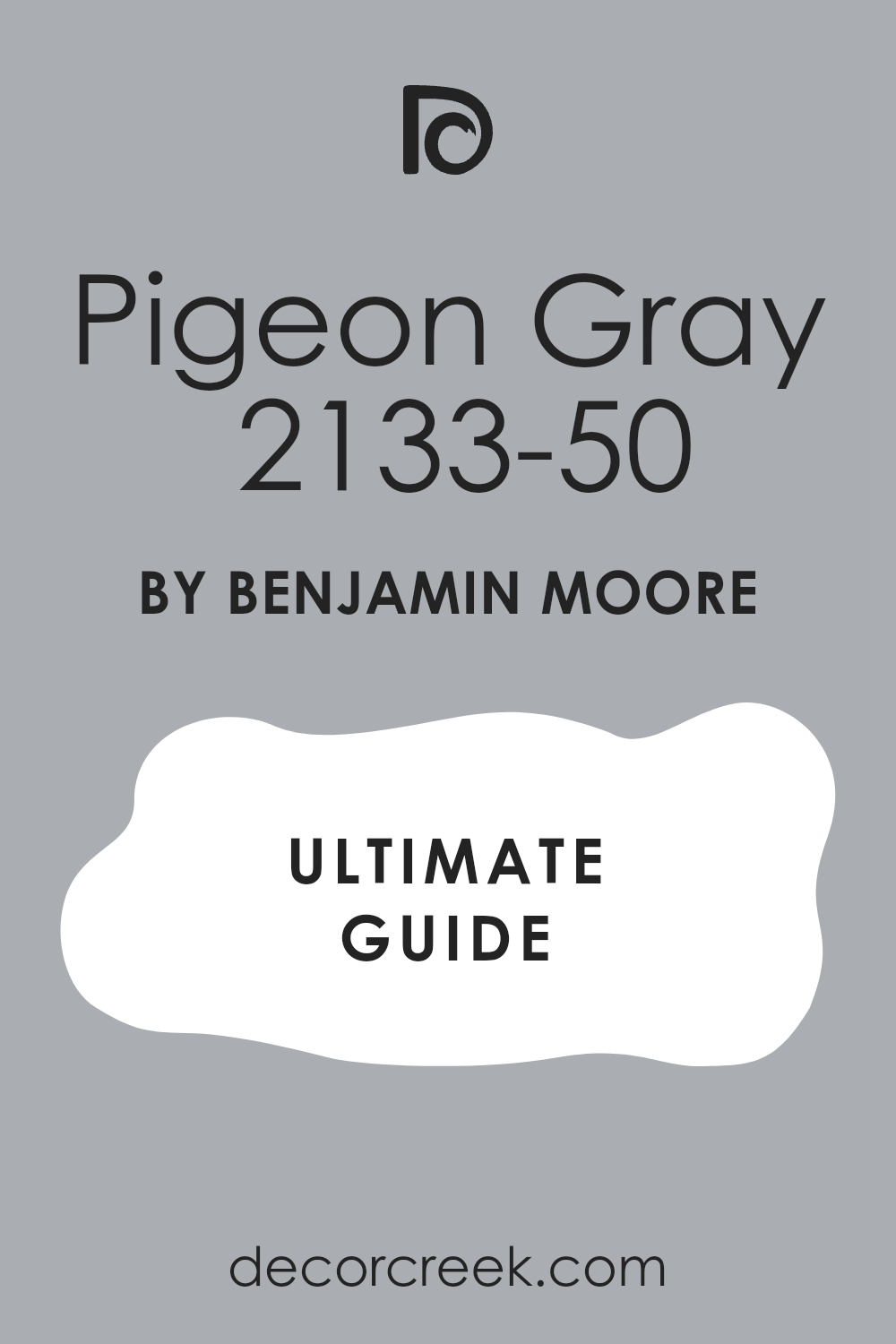
Ever wished paint sampling was as easy as sticking a sticker? Guess what? Now it is! Discover Samplize's unique Peel & Stick samples.
Get paint samples




